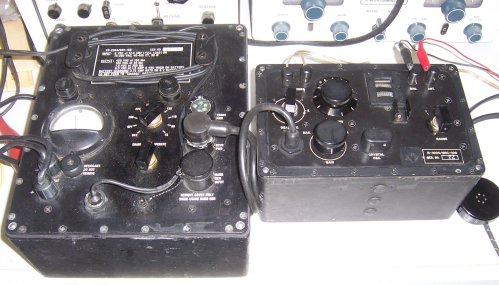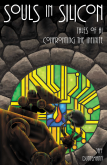- My old friend Lee Hart scratchbuilt a marvelous model of the Galileo spacecraft, including an operating COSMAC processor that blinks out the Arecibo message on an LED.
- The COSMAC 1802 was a good choice for spacecraft, because it drew almost no power and could be radiation-hardened. It was all static CMOS, so the system clock could be slowed arbitrarily, down to audio rates, or just stopped. Alas, the contention (which I’ve shared) that there was an 1802 on the Viking spacecraft isn’t true. Bummer.
- Here’s an essentially bottomless collection of old radio literature, including magazines, technical books and articles, and ephemera. The PDFs are of excellent quality, though I wonder how legal some of the items are. Worth a look, for the Deco artwork in the 20s and 30s magazines, if nothing else.
- And if you’re interested in toilet paper on a total lifestyle basis, Toilet Paper World is just the thing. I’m not sure I even noticed that tinted toilet paper existed before they told me. And now it’s gone. I guess it’s true that 80% of the world is always below our radar.
- We’ve had air rifles since…1779. (Thanks to Pete Albrecht for the link.)
- I’d heard about how the Soviets repaired their ailing Salyut 7 space station, but not in anywhere close to this kind of detail.
- Paris used to use (and may still; the article is unclear) a sort of Indiana Jones mechanism for clearing blockages in its extra large economy-sized sewer pipes: Rolling a 9-foot iron ball through them.
- If you’re watching sea ice levels in the Antarctic (as I am) this site puts up very nice graphs on an almost daily basis.
- Is there anything that hipsters can’t ruin? (Thanks to Bruce Baker for the link.)
- Murder comes naturally to Chimpanzees. The sad part is, it comes naturally to us, too. I suspect it came so naturally to the Neanderthals that they didn’t need Sap to extinctify them.
- Somehow I managed to see the first Hobbit flick four times and never noticed that Bifur had an axe stuck in his head. I thought it was some sort of ornamment.
- Oh, and predictably, Buzzfeed has a stack rank of Peter Jackson’s dwarves by, um, hotness. They should have asked some Dwarf women; the hottest dwarves are also the ones that look the least like dwarves. Several times I was asking myself if Fili and Kili had been left in a basket on some dwarf’s front porch.
- One more and I’ll let the dwarf thing go. Separated at birth: Bofur the Dwarf and…Sister Bertrille.
- I survived the 60s. I had all the Beatles albums. I am not and have never been a Communist. I guess this means that hypnotism is impossible.
electronics
Odd Lots
Odd Lots
- Yet another take on the Amazon vs. Hachette dust-up: The publishers contributed to Amazon’s monopsony power by demanding platform lock-in via Kindle DRM. And now they’re surprised that Amazon controls the ebook market. (Thanks to Eric Bowersox for the link.)
- Pete Albrecht sent word that some guys at the University of Rochester have figured out how to trap light in very small spaces for very long times, on the order of several nanoseconds. (This is a long, long time to be stuck in one place if you’re a photon.) It’s done with evolvable nanocavities–and that gives me an idea for a tech gimmick in my long-planned novel The Molten Flesh. So many novels, so little time…
- Related to the above: The reason I stopped working on The Molten Flesh three or four years back is that I ordered a used copy of the canonical biography of Oscar Wilde (who is a character in the story) and the book stank so badly of mold and mildew that I threw it out after sitting in a chair with it for about five minutes. Time to get another copy.
- Yet another reason not to bother with The Weather Chanel: WGN’s weather website is hugely better, doesn’t require Flash, and works nationally, not only in Chicago.
- Lazarus 1.2.4 has been released. Go get it.
- OMG! STORMY, have you been messing around in Nebraska again?
- Over at Fourmilab we have a superb scan of the 1930 Allied Radio catalog, which carried not only radios and parts but waffle irons, home movie projectors, coffee percolators, toasters, copper bowl heaters, electric hair curlers, and much else for the newly minted upper middle class. (Thanks to Baron Waste for the link.)
- One interesting thing about the radios in the Allied catalog above is that they’re shouting about screen grid tubes. Tetrodes were invented in 1919 and weren’t in mass production until the late 1920s. I’m guessing that tetrodes were what separated the extremely fussy triode-based radios of the 1920s from the turnkey appliance radios of the 1930s and beyond. What the tetrode began the pentode completed, of course, but the watershed year in appliance radio seems to have been 1930.
- Our current Pope has abandoned the bullet-proof Popemobile. It’s one step closer to the end of the Imperial Papacy.
- What dogs think of dog impersonators. Hey, man, the lack of a tail gives it all away…
Cranking Up the GRC-109 R-1004

While everybody else yesterday was running around looking for foot bras and the world’s smallest volcano (more on which in the next Odd Lots) I was tidying up my shop/shack, and pulled down my AN/GRC-109 Special Forces radio system. I’ve had it since the mid-1990s, but hadn’t fired it up literally since we left Arizona in 2003. I don’t have the full list of accessories so I had to do a little lashing-up to get the R-1004 receiver connected. It didn’t disappoint me.
I have the CW-only T-784 transmitter as well. I don’t use it because I’ve largely lost my CW chops and the only guys still pounding brass are whistling along at 20+ WPM. Not having an antenna that won’t set off my security system is the other issue. (Shielding the heat sensor it triggers it is not an option due to insurance regs.) My outdoor dipole will go up as soon as we have a few leaves on the tress, whenever that actually happens.
So. What we have here is a vintage all-tube spy radio, where the spies either have stealth jeeps or very strong backs. The design came out of the CIA in the late 1940s, and was adapted for more general use in the 1950s. It was used until the end of the Vietnam War. The receiver weighs 8.75 pounds all by itself. The PP-2684 power supply will weigh you down another 25 pounds or so. (There’s a lighter, smaller power supply, the PP-2685, that I don’t have.) The receiver uses conventional 7-pin miniature battery-filament tubes in a fairly simple superhet circuit. The only glitch there is the 1L6 converter tube, which is hard to find and costs a small fortune when you find it. The 1L6 is scarce enough so that people have designed solid-state replacements for it.
The R-1004 tunes from 3 MHz to 24 MHz in three bands. Selectivity is good, hardly single-signal but a reasonable compromise for a set designed to receive both AM and CW. I had to grin at how spoiled I’ve gotten by modern digital rigs like my IC-736, which can tell you to a single cycle where you are. The dial is pretty accurate, reading bang-on for WWV at 5 and 10 MHz, but it’s a wide dial, and lacks a vernier. Sensitivity seems lower on the 12-24 MHz band. No matter; in the evenings all the action is at 12 MHz and down.
SSB was still pretty exotic when the R1004 was designed, and yet its BFO is solid enough that I didn’t have to “chase” sideband signals on 40 and 75 meters with either the tuner or the BFO knob. AM quality was good, considering that it has caps to roll off audio response past 3 KHz. I tuned the entire range from 12 MHz down to 3, stopping at the ham bands or anything else unusual. I used to do that a lot before I was licensed as WN9MQY in 1973. I was hoping to find a numbers station (are there still numbers stations?) or one of those long-extinct semi-musical beacons that I used to hear in 1965. SWBC hasn’t really changed much since 1970: Christian stations, national stations, some German and French, and a lot of things too far down in the noise to quite make out. Canadian time station CHU is no longer on 7335 KHz, but a quick Google check pointed me to its new location at 7850 KHz. I listened to an AM net on 7290, and was startled when K5MIL’s big signal came up and forced me to turn down the gain–he’s only 5 miles north of me, and running a fair bit of power.
Talk about old times, whew.
My R-1004 hasn’t seen much hard use; I’d almost call it pristine. Serial number 25. By contrast, the power supply has been around the block–or maybe the world–a few times, and when I bought it I had to do some fussy needle-file work to get the corrosion off the power connectors. It sounds goofy, but I love how this gear smells: bakelite and black rubber, with undercurrents of oil and perhaps solder flux. (Radio terroir!) If ever there were a canonical Dieselpunk radio, well, here it is. My only gripe is that my high-Z “cans” headset gave me a headache after squeezing my ears for an hour, and I really need to lash up an audio transformer to take the R-1004’s 4000 ohm output impedence down to whatever my cushy padded headset likes. I’ve done this before, but alas, the adapter unit (built into a 70s contacts case I got from Carol) is hiding somewhere.
No matter. You’ve seen my shop and my collection; it will be done. When we can manage a nerd party here sometime this summer, I’ll put it out on the deck and drop a wire over the edge if I haven’t done so already. Put the black thing up against your ear, young’un: That’s what the Internet was when I was mowing the lawn and not chasing you off of it!
New Photo of John T. Frye

Reader George Cohn sent me a photo of John T. Frye that I had not seen before. It’s from the May, 1948 issue of Radio News, which contained the second installment of his very long-running “Mac’s Service Shop” column. Assuming the photo was recent when published, Frye would have been 38.
For those who don’t recognize his name, John T. Frye was the author of the Carl & Jerry educational stories from Popular Electronics, “Phone Phunnies” from QST, and a whole metric passel of other things in other places, including two books on tube-era radio servicing that from what I can tell have passed into the public domain. See my article on Frye and his creations Carl & Jerry. I republished all 119 stories in five books several years ago (plus one new storyI wrote myself, and another one from the late George Ewing WA8WTE) and they’re still selling. Frye was a paraplegic who never walked, and how he did what he did in his life is one of the great success stories of disabled people who just didn’t let anything get them down. Legs? We don’t need no steenking legs!
Wayne Green W2NSD, SK
It’s hard not to have an opinion about Wayne Green. Depending on whom you listen to, he was a visionary, a crank, delusional, eccentric, generous, lecherous, honest, optimistic, boundlessly energetic, or all of the above and maybe a few more. Someone wrote a bogglingly angry book once (I had it but have misplaced it) that spent its entire length trying to persuade us that he was a liar, a scoundrel, a thief, and had nothing whatsoever to do with the creation of Byte Magazine. Anger that dense warps the fabric of truth. (Be careful with your anger. Let it get too dense and you will vanish into a black hole of lost credibility from which you may never emerge.) Don Lancaster put the lie to it without any trouble: When Don was writing for the extremely early Byte, Wayne was there, buying articles and signing checks.
That said, Wayne Green said a lot of peculiar things about a lot of things both mundane and peculiar. He said he was richer than (as best we know) he actually was. He said he was sexy and available. (One out of two ain’t bad.) He was constantly bitching and moaning about the FCC, the ARRL, and lord knows what else. He bragged about affairs he had had with his editorial staff. He published articles about homebrew radio gear that simply couldn’t work, or were such peculiar lashups of pipe fittings, power tubes, trash cans, glue, staples, beer bottles and copper tubing that nobody wanted to try. (I say this with some affection. Many of those articles were by the late Bill Hoisington K1CLL, who admitted…gasp!…that VHF/UHF circuits could be cranky. The crankiness of those circuits led him to try a lot of things that looked dicey, but to me their craziness indicated a certain honesty about how cranky VHF/UHF electronics actually are. Which is, of course…cranky.) There is a long list of things that Wayne Green did here. How many are true is hard to say. Did he really pilot a nuclear attack sub? Scary notion, if you’ve read his editorials. The truth, I suspect, is that he was a legend in both senses of the term.
Wayne Green, whether he was crazy or not, remains one of my heroes, for this reason: He bought the first piece of writing I ever sold, but not the first I ever had published. I guess I need to clarify: When the article appeared in the December 1974 issue of 73 Magazine, it was not my first publication. I had sold “Our Lady of the Endless Sky” to Harry Harrison for Nova 4 about a month later, but Wayne, as was his wont, paid me immediately and then sat on “All the World’s a Junkbox” for over a year before getting it into print. (“Our Lady” was in my hands in September.) And then he changed the title, to the inane “Zillions of Parts for Nothing.” (See page 36 of that issue.) Was I annoyed? A little. But heck, you only sell your first article once.
I subscribed to 73 for a lot of years, and have most of a full run of the mag on my shelves. Wayne was an editor of CQ for years before 73 appeared. Both magazines were lively and entertaining under his watch. The tech ran hot and cold, as it did almost everywhere but QST, which had paid techs on staff to build things and make sure that they were a) buildable and b) worked. But boy, when the late George Ewing WA8WTE and I got together on 40M, as often as not Wayne’s latest editorial was tops on our rag-chew agenda. Wayne published books, too, including George Ewing’s Living on a Shoestring, which George called “my scrounge book” and I consider a marvelous technical memoir. For a little while Wayne published a magazine called Cold Fusion Journal, which may have been the best fit of an editor with his niche that we will ever see.
Wayne died a few days ago, on the 13th. He was 91. His brief article on Wikipedia indicated that he was ready and eager to go off adventuring in the afterlife, an attitude I much admire. We speculate about what happens to good people after death, and what happens to bad people. What, then, happens to crazy people? Does God try to “fix” them, or do they just go on being crazy? “Crazy” is a debatable term, of course, but it seems to me that if Wayne Green weren’t his very particular brand of crazy, he wouldn’t be Wayne Green anymore. And that, my friends, would be a tragedy, whether here or in the afterlife.
TNX ES 73 OM DE K7JPD SK.
Ohm’s Law Is a Bitch
Jimi Henton, the local breeder from whom we got Aero, Jack, and Dash, brought me her dog grooming dryer some time back to see if I could figure out what was wrong with it. Carol has the exact same dryer, a Chris Christensen Kool Dry. It’s basically an SCR-controlled variable-speed fan in a box, putting out 114 CFM through a hose.
Jimi said it wasn’t blowing as much air as it used to, even after she cleaned the filter and made sure nothing else was gummed up with dog hair. It still blew, and the pot still varied the fan speed, but it wasn’t as loud and clearly didn’t have its out-of-the-box oomph. Worse, she’d had a new motor installed last year. The first one had gone for eleven years before dying; this seemed kind of premature.
I wanted to compare the two dryers to get a sense for how much air was being lost in Jimi’s. I have no way to measure airflow here, but sitting on the laundry room floor I noticed Jack’s little soccer ball, much reduced from its original size, but still round enough for my purposes. With only a little skill I managed to get the ball levitating over the nozzle, as any kid who’s bright enough to put a vacuum cleaner in reverse has done. On Carol’s dryer, the ball wobbled between 18″ and 24″ above the nozzle. On Jimi’s, it was maybe 4″.
So there was work to do, somewhere. Upon opening the dryer up, at least one problem was obvious: The 1,025 watt AC motor was wired to the speed control with #24 telephone wire, and too much of it. (You know, the stuff with the two-color, bands-on-solid insulation.) Close inspection showed two cold solder joints, coincidentally (heh) where the #24 wire hit the speed control pot. The plastic insulation on the phone wire was blackened with heat. The dryer slowly was cooking itself from the resistance of all that skinny wire. No need for a fork; it was done.
Jimi had ordered the motor from the manufacturer and then had somebody local put it into the dryer. She called him an amateur. No. I’m an amateur, with a callsign to prove it. I do electronics because I love it. Whoever installed this motor was…an idiot.
All fixed now, using some #14 stranded wire and soldering skills I learned when I was eleven. Both dryers now loft the soccer ball two feet hgh. Ohm’s Law is a bitch, dude. Please go back to sharpening scissors.
Odd Lots
- Wow. Dig with a backhoe, and then spray a target with a machine gun. Only $384. Writers should get out and do all kinds of things that aren’t part of everyday life for writers. I’m not a big fan of Las Vegas, but I could see myself doing this.
- Ok, this is clever. Forgive me if I don’t believe it will work.
- Here’s a service that the world needs, but I don’t give it even a year, especially now that Wired has launched it into high visibility. Big Print doesn’t want us too comfortable with the notion of scanning books we own to ebooks.
- Here may be one reason why: A consortium of tech book publishers is going after two anonymous Usenet posters who have posted literally hundreds of thousands of books (including several of mine) on alt.binaries.e-book.technical, not once but many times over the past several years. I’ve monitored that group since 2008 or so. It’s astonishing.
- Yes, I’m a crank. I hope to be a crank who lasts awhile. Shorting sleep will kill you. There are some excuses (small children at home being the biggie) but I also wonder if college life makes us night people. Most of the morning people I know (Carol and myself included) lived at home during college. (Thanks to Alan Zeichick for the link.)
- And though I’m not a necromancer, I know that you’re bound to answer when I propose: Everything’s SCO’s!
- Baby armadillos are cute, but I’m not sure I’d hold one, because they can carry leprosy. (Ok, ok…just wash your hands afterwards!)
- After all, armadillos are all that’s left of my favorite Pleistocene megacritter, the glyptodont. (Pssst: Mister pinch-hitter, that’s not a good stance to take!)
- Paywalled, but read it if you’re a subscriber: Ford is putting buttons back on their dashboard. I’m having some reliability problems with my new knob-less car stereo, and if I return it I may insist on something with a volume control knob at very least. They exist.
- And they exist in half-height too. Now I’m wondering if I can get a 2M/440 mobile rig that will fit in the other half of the bay…
- I had one of these once. I was called a “young punk” on occasion, by those who had reason to think it was true. So I was a steampunk long before it was cool.
- I was a little early for the Lego phenom, and was quite happy to be a Meccano kid. Here’s a great overview site for all the metal constructions sets I’ve ever heard of. (Except for Buildo, which was obscure even in 1960.)
- That said, don’t tell Certain Small Girls, but one of these may be under A Certain Christmas Tree this year.
- Colorado and Washington State will make this at least possible. But…but…what if your dog is under 21?
Measuring Raspberry Pi USB Power Draw

Most of the problems that turn up while configuring Raspberry Pi systems cook down to inadequate power. The infamous stuttering keyboard problem vanished immediately here when I put the RPi on a stiffer 5V supply. When I bought a second RPi for a programming system, I incorporated a powered hub capable of sourcing 500 ma from each port, and in doing so strangled the power problem in its crib.
Problem solved, but I still wondered: How much juice do these things actually need? How stiff is the 5V supply? I’m a bench tech, and not being able to do actual measurements made me nuts. So I sniffed around a bought a test instrument for measuring voltage and current at a USB port under load. It’s the Smartronix USB Power Monitor, model ST034TT05-01-001. I bought it from CyberGuys; $49.95.
It works like any current meter: You connect it between a USB port and a USB device. It simultaneously measures the voltage on the port and the current through the device. There’s a full-size Type A jack on the right side of the box for connecting the load, and a full-size AB cable plugging into a B jack on the left side of the box, which plugs into a Type A port.
Works like a charm. I did the measurements below in about ten minutes:
| Raspberry Pi board running Raspbian, w/o Wi-Fi | 50-73 ma |
| Dell 0C8639 wired USB mouse | 5-17 ma |
| Dell SK8135 wired USB keyboard | 53-56 ma |
| AirLink AWLL5088 Wireless N Ultra Mini USB Wi-Fi | 32-80 ma |
| SanDisk Cruzer Mini thumb drive, 256 MB | 27-30 ma |
| SanDisk Cruzer Micro Skin thumb drive, 256 MB | 75-89 ma |
| San Disk Cruzer Mini thumb drive, 512 MB | 7-11 ma |
| KingMax Super Stick thumb drive, 512 MB | 35-62 ma |
| SanDisk Cruzer Mini 1 GB thumb drive, 1 GB | 5-11 ma |
| SanDisk Cruzer Micro Skin thumb drive, 4 GB | 75-91 ma |
| SanDisk Cruzer Micro Skin thumb drive, 8 GB | 43-70 ma |
In the readings above, the two numbers are the range across which I saw current run. In most cases, the first number is when the device is idle, the second is when it’s busy. All measurements were taken from the same USB port, one of the four ports on the Rosewill powered hub. All devices tested are USB 2.0, because the meter itself is not listed as capable of testing USB 3 devices.
I have several of most of the thumb drives, and identical models were almost alike in their power behavior. This made me wonder how the Cruzer Minis managed to use so little power while doing the same task that all the other drives did. In this case, the task was copying a 109 MB file (the Lazarus 1.0.6 installer) from the PC to the thumb drive. One would think that smaller drives would draw less current, but not so.
Probably the biggest eyebrow-raiser was how rubbery the 5V USB rail is on my quadcore. An 8GB Cruzer Micro Skin thumb drive pulled the port down from 4.99 v to 4.91 v while drawing 90 ma. The same drive pulled the Rosewill hub supply down by only .02 v , from 5.17 v to 5.15 v while drawing 70 ma. (Current draw in thumb drives is not the same on the RPi as it is on Windows.)
My only gripe about the meter is that “peak” mode displays the highest values for voltage and current, when voltage and current generally move in opposite directions as load increases. So a downward movement in voltage isn’t registered in peak mode.
Other than that, it works as described and answered a whole lot of questions about what sorts of things I can reasonably expect to connect to a Raspberry Pi’s built-in USB ports. Actually, I now recommend using the powered hub for everything, given the RPi’s touchiness about power. It makes the RPi system bulkier and snakier, but a whale of a lot more reliable.
And as for the Smartronix USB power meter, let’s say solidly (if not quite highly) recommended.
Odd Lots
- Egad. No, egad squared: A major literary agency has asked to see the full manuscript of Ten Gentle Opportunities. The novel is done, but I still have to format it for submission and write the synopsis and logline. I’m going to be busy for a few days, that is fersure.
- IBM is taking a new slant on fluidic computers, one that operates via charged fluids. The hope is that this will allow better modeling of human brain operation. I’m skeptical, but hey, it’s a species of nanocomputer, and I’m certainly bullish on those. (Thanks to Mike Reith for the link.)
- If anybody reading this has a 3D printer, I’d like to ask: Does the extruded plastic stick to clean copper-clad PCB stock? The obvious idea is to lay down a single-slice pattern in the form of PC pads and then etch the board with the plastic as resist. I don’t see much about this online.
- From Chris Gerrib: How American radio stations got their call signs. One minor refinement: US callsigns beginning with AAA-ALZ and NAA to NZZ are not exclusively military. Amateur radio callsigns have used those prefixes for at least 35 years. (An OTA friend of mine outside Chicago got his Extra and selected AA9J as his call in, I think, 1976.)
- People always seem to be recording meteors on dash cameras. I now have a dash camera. If I put it on my dash, will I see a meteor? Or will I get my money back? (Whoops. Found it in the bushes. All finds final. No refunds.)
- Speaking of dash cameras: The manufacturer of the little sports camera I found in my bushes issued a DMCA takedown notice to a reviewer, on trademark grounds. (The DMCA has nothing to do with trademark abuse.) Hey, GoPro, Barbra is singing. Backtracking about the blunder will not help you. (Thanks to Tom Roderick for alerting me to this.)
- Salads are way more dangerous than hamburgers. Alas, you can’t grill salad until it’s done to the center.
- From Michael Covington comes a link to a story about how a Medieval copyist’s cat peed on his manuscript. The scribe drew a peeing cat on the damaged section, with an appropriate curse in Latin.
- And we think we have a junk DNA problem: Amoeba proteus has 290 billion (yes, billion) base pairs in its genome, as compared to homo sap’s piddling 2.9 billion.
- The reason all of us baby boomers didn’t die as grade schoolers may be that none of us lived in rich-guy gonzo-modern homes like these. (Why did I think that these houses were designed to ernhance estate tax revenues?)
The Five Minute Electrostatic Charge Detector

I’ve been building electronic gadgets for almost fifty years, and I don’t think I’ve ever managed a working five-minute project before. If the photo above shows a slightly random assembly style (I’m typically more artful, whether or not the circuit requires it) that’s because I wanted to complete it in five minutes.
I did. And it works. When I snapped the picture, I was holding my hand about six inches from the gate lead of the MPF102. When I pulled my hand back about a foot or so, the LED went out. If I scuff around my static generator of an office, it “sees” me even two or three feet away. The sensing “antenna” is nothing more than the gate lead of the FET, left loose in mid-air. A short scrap of wire three or four inches long would have increased the range greatly.
The circuit came to me from Bill Beaty, who posted a comment with the link to my February 18, 2013 Odd Lots entry. It consists of an MPF102 JFET, a generic red LED, and a 9V battery plus its associated connector. I lashed it up on a scrap of perfboard with a total of three solder joints. Bill found me because of this post, to an old Popular Electronics electroscope project using a 6J7 tube instead of an FET. (They didn’t have MPF102s in 1961.)
Sure, it’s a stunt, but I was in a stunt mood. Remember, if you try this and it takes a little more than five minutes, that I’m good at this stuff, and had gathered all the parts to my workbench before starting the clock. And clock it I did: the stopwatch said 4:39 when I snapped in the battery, leaned toward the gate lead, and saw the light come on.
I’m still considering a tube-based device using some sort of neon light more exotic than an NE-2. I’m considering an NE-34, and would have had one by now if they didn’t cost so much. Or an Aerolux bulb, if I’m feeling Art Nouveau-ish. Those cost even more.
I can feel my resistance crumbling. Remember: It’s futile.










